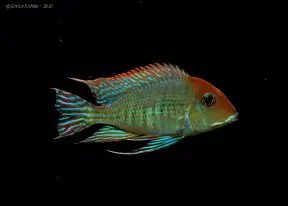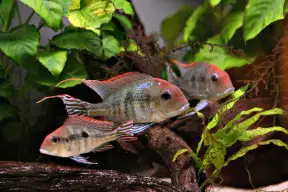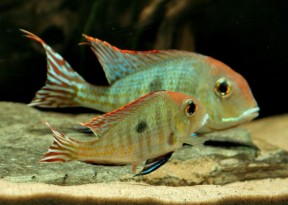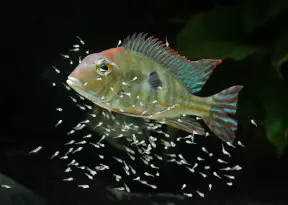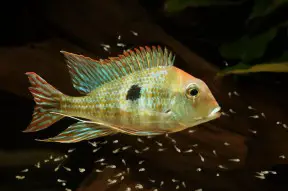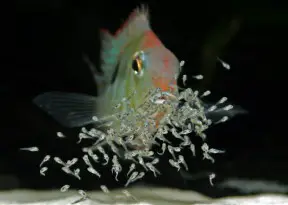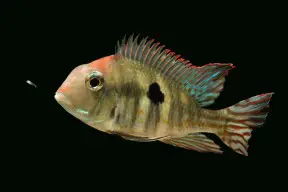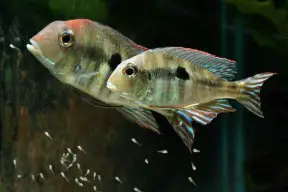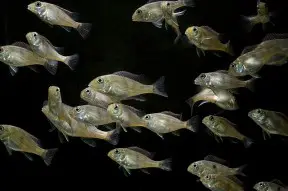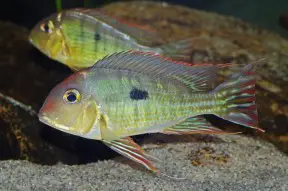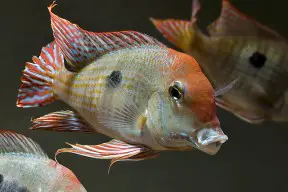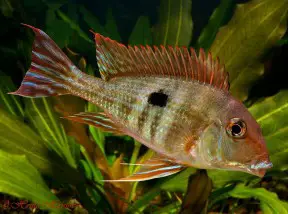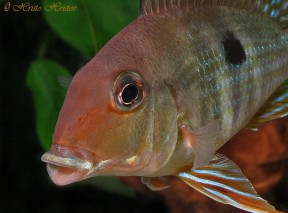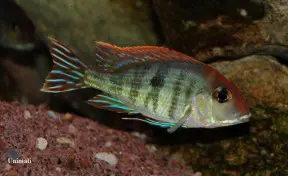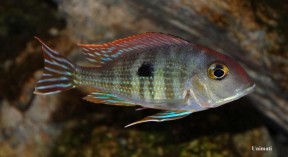Geophagus sp. 'orange head'
Etymology
Geophagus: from the Greek geo, meaning ‘earth’, and phagos, meaning ‘ to eat’.
Classification
Order: Perciformes Family: Cichlidae
Distribution
First collected in 1991 by German aquarists Christop Seidel and Rainer Harnoss (Steinhaus, 2010) from the rio Tapajós, eastern Brazil.
A second form which differs slightly in head colour and morphology later appeared in the trade as G. sp. ‘orange head Araguaia’, referring to the major tributary of the rio Tocantins.
The rio Xingú lies between the Tapajós and Tocantins so this led to speculation that there should exist an ‘orange head’ form in that drainage, too.
However it’s now known for certain is that there exists no ‘orange head’ Geophagus species in the Araguaia or Xingú – it is in fact highly endemic and confined to the lower Tapajós.
The ‘orange head Araguaia’ form mostly inhabits the main river channel while the more intensely-coloured variant occurs in the rio Arapiuns.
The latter tributary empties into the Tapajós close to its mouth, on the opposite bank to the city of Santarém and a little downstream of the Alter Do Chão lagoon which is the primary collection point for the aquarium trade.
Habitat
The Arapiuns ia an acidic blackwater river characterised by low mineral content, pH and clear, tannin-stained water.
The Tapajós main channel contains so-called ‘white’ water with a slightly acidic to neutral pH and low hardness but significant amounts of material in suspension at times giving it a cloudy appearance.
In both cases favoured habitats are gently sloping marginal zones around shores or islands with soft substrates of bare sand or mud.
Depending on locality other features can include scattered rocks, submerged tree roots, branches and leaf litter.
At the confluence of the Tapajós and Arapiuns G. sp. ‘orange head’ was observed in clear water (visibility close to 20 m) which was flowing moderately over a substrate consisting of submerged boulders with long stretches of white sand between.
There was little in the way of vegetation or wood, pH was around neutral and adult specimens could be observed swimming in pairs with sexually inactive individuals congregating in groups of up to 20 (J. Cardwell, pers. comm.).
Other species known from the Tapajós and available in the hobby include Hyphessobrycon pulchripinnis, Nannostomus beckfordi, Metynnis argenteus, Pterophyllum scalare, Satanoperca jurupari, Heros efasciatus, Mesonauta festivus, Laetacara curviceps, Ancistrus dolichopterus, Hypancistrus sp. L260 and Peckoltia compta/L134 plus a number of occasionally traded ones such as Hyphessobrycon heliacus, H. vilmae, Dicrossus maculatus, Corydoras ornatus, Panaque sp. L027 (aka P. sp. cf. nigrolineatus `Tapajós’?), Leporacanthicus joselimai/L264, Peckoltia snethlageae/L141/L215 and Pseudacanthicus sp. L273.
There’?s also another undescribed Geophagus species from the lower Tapajós which has a smaller dark marking on each flank, lacks the orange head colouration and has appeared in the trade as G. sp. ‘Tapajós II’.
Maximum Standard Length
200 – 250 mm.
Aquarium SizeTop ↑
An aquarium with a base measuring 180 ∗ 60 cm or more is required to house a group long-term.
Maintenance
The most essential item of décor is a soft, sandy substrate so that the fish can browse naturally (see ‘Diet’).
Coarser materials such as gravel or small pebbles can inhibit feeding, damage gill filaments and even be ingested with the potential of internal damage or blockages.
Additional furnishings are as much a case of personal taste as anything else but the most favoured set-ups tend to feature relatively dim lighting plus some chunks of driftwood and scattered roots or branches.
Leaf litter is a typical feature of the natural environment but not really recommended in aquaria because the feeding behaviour of Geophagus spp. tends to cause an excess of partially-decomposed material in suspension which not only looks unsightly but can block filter and pump mechanisms.
One or two flattish, water-worn rocks can also be included to provide potential spawning sites if you wish.
Water quality is of the utmost importance since these cichlids are extremely susceptible to deteriorating water quality and swings in chemical parameters so should never be introduced to a biologically immature aquarium.
The best way to achieve the desired stability is to over-filter the tank using a combination of external canister filters and/or a sump system and perform minimum weekly water changes of 50-70%.
If the maintenance regime is insufficient health issues such as head and lateral line erosion or stunted growth can occur.
Mechanical filtration should also be tailored to trap small particles stirred up by the fish as sand can cause blockages and wearing issues with filter mechanisms if allowed to continually run through the system.
High flow rates should be avoided so position filter returns accordingly.
Water Conditions
Temperature: 26 – 30 °C
pH: 4.5 – 7.5
Hardness: 18 – 179 ppm
Diet
Geophagus spp. are benthophagous by nature, employing a method of feeding whereby mouthfuls of substrate are taken and sifted for edible items with the remaining material expelled via the gill openings and mouth.
For this reason they’re commonly termed ‘eartheaters’ and the provision of a suitable substrate is essential to their long-term well-being.
Once settled they readily rise into the water column when food is introduced but continue to browse normally at other times.
The stomach contents of wild specimens mostly comprise small aquatic and terrestrial invertebrates, plant material in the form of seeds, organic detritus and sediment.
Even as adults these cichlids seem unable to properly ingest larger food items meaning the diet should contain a variety of high quality, fine-grade prepared foods plus small live or frozen bloodworm, Tubifex, Artemia, mosquito larvae, etc.
At least some of the dried products should contain a high proportion of vegetable matter such as Spirulina or similar.
Home-made, gelatine-bound recipes containing a mixture of dried fish food, puréed shellfish, fresh fruit and vegetables, for example, are proven to work well and can be cut into bite-sized discs using the end of a sharp pipette or small knife.
Rather than a single large meal offer 3-4 smaller portions daily to allow natural browsing behaviour as this seems to result in the best growth rate and condition.
Behaviour and CompatibilityTop ↑
Unless breeding this species is surprisingly peaceful and will not predate on fishes larger than a few millimetres in length.
Suitable tankmates are far too numerous to list but include most peaceful species enjoying similar environmental conditions.
Best avoided are aggressive or territorial substrate-dwelling species, or those requiring harder water.
Some aquarists keep Geophagus spp. alongside freshwater stingrays of the genus Potamotrygon which in many cases has proven successful but in some has resulted in them disappearing at night.
G. sp. ‘orange head’ is gregarious and tends to exist in loose aggregations unless spawning, with juveniles in particular displaying strong grouping instincts.
A group of 5-8 individuals should be the minimum purchase and these will form a noticeable dominance hierarchy.
When maintained in smaller numbers weaker specimens can become the target of excessive antagonism by dominant individuals or the group may fail to settle and behave nervously.
Sexual Dimorphism
Males are more intensely-coloured than females, tend to be a little larger and develop longer fin extensions. Some dominant individuals develop a nuchal hump as they mature.
Reproduction
Substrate-spawning, larvophilous, biparental mouthbrooder that has been bred in aquaria.
There doesn’t appear to be any particular trigger for the spawning process with the main requirements being good diet and stringent maintenance regime involving relatively large weekly water changes.
Since accurate sexing is very difficult it’s best to begin with a group of young fish and allow pairs to form naturally.
A degree of patience is also required since it can be at least a year until they become sexually mature.
Courtship is relatively unobtrusive consisting of fin flaring, circling, gaping and head jerking displays, and when ready to spawn a pair will select a suitable site.
This is normally a piece of décor such as a flat rock or section of driftwood although it’s not unknown for the base of the aquarium to be used.
The chosen area is then cleaned and defended against intruders.
Spawning occurs in typical substrate–spawning style with the female laying one or more rows of eggs before the male moves in to fertilise them, the process being repeated numerous times over a period of several hours.
Post-spawning the female stays close to the eggs, tending and defending them against intruders while the male is responsible for defence of the surrounding territory.
After around 72 hours the eggs hatch and fry immediately taken into the mouth of the female although on some occasions both parents may be involved from the start.
Once the fry are free swimming brood care/defence is shared although this varies depending on the male with some individuals becoming involved earlier and others not at all.
Some females therefore continue to hold all the fry or may even be driven away by the male to care for them alone.
In other cases both parents hold fry simultaneously or exchange the entire brood between one another on a regular basis, with such transfers tending to take place in a sheltered location such as a depression in the substrate.
When not brooding the adults will normally feed, and may even take some small morsels while holding fry.
The fry become free swimming at 8-11 days of age and the parents begin to release them to feed, initially with caution but for increasingly longer periods.
If danger is sensed the fry are shepherded back into the adults’ mouths, with rapid movement of the ventral fins appearing to act as a signal.
As time elapses and the fry grow they may only return to their parents’ mouths at night while the size of the territory becomes correspondingly larger.
They’re easily-fed, accepting good quality powdered dry foods, Artemia nauplii, microworm, etc., as soon as the free-swimming stage is reached.
If maintaining the adults in a community situation it’s recommended to remove brooding females as the fry become easy prey for other fishes, including conspecifics, once released.
NotesTop ↑
This undescribed species is also known as G. sp. ‘red head Tapajós’ but when first exported for aquaria was referred to as G. sp. ‘orange head’ so that name is given priority here.
It’s achieved great popularity in the hobby and is now one of the more readily available members of the genus.
Unfortunately this ‘fashionable’ status has led to quality issues with many commercial breeders producing the species with no regard to culling deformed fry, for example.
If wild fish are unavailable buy from a reputable shop or hobbyist.
There are at least two variants available one of which is usually traded as G. sp. ‘Araguaia orange head’.
This is misleading since both are endemic to the Tapajós drainage (see ‘Distribution’), and appears to date back to an error in collection locality when the fish were first exported.
The two differ in the extent of orange colouration on the head which extends onto the opercle in G. sp. ‘orange head (rio Arapiuns form) but is mostly restricted to the area above the eyes in G. sp. ‘Araguaia orange head’ (Tapajós main channel form).
There is also a solid bar of orange pigmentation running along the dorsal surface between dorsal and caudal fin in the Arapiuns form which isn’t present in the Tapajós variant.
The intensity of both head and dorsal stripe appears to be directly related to age, gender and social position, with dominant adult males displaying the greatest extent, although in general the Arapiuns form is the more brightly-coloured.
Despite these differences the two forms appear to represent a single species which should undoubtedly be included in the putative G. surinamensis ‘group’ within the genus.
Since no other members possess the orange head colouration it’s also among the easiest to distinguish.
Young specimens also have five dark, parallel, vertical bars on the body (normally visible only when the fish are stressed, spawning or preserved) of which the anterior four become bifurcate (vertically split) as the fish mature.
There are no dark preopercular markings and caudal-fin patterning consists of irregular, alternating reddish and bluish to whiteish horizontal bands.
Representatives of the G. surinamensis assemblage are diagnosed by their relatively deep head and body shape, possession of a variably-sized dark spot on each flank and presence or absence of a small, dark preopercular marking.
There are currently thirteen described members but diversity is predicted to eventually prove much greater with a number of undescribed forms known some of which, such as G. sp. ‘orange head’ and G. sp. ‘Pindaré’, are regularly available in the aquarium trade.
The described members of the group are G. abalios, G. altifrons, G. brachybranchus, G. brokopondo, G. camopiensis, G. dicrozoster, G. megasema, G. neambi, G. parnaibae, G. proximus, G. surinamensis, G. sveni and G. winemilleri.
Only five Geophagus species aren’t included, namely G. argyrostictus, G. gottwaldi, G. grammepareius, G. harreri and G. taeniopareius.
These are most easily separated on the basis that they all possess a complete infraorbital stripe but oddly have not had their own group name assigned, usually being referred to simply as ‘non-G. surinamensis group’ species.
Accurate identification of G. surinamensis group members has been problematic for a number of reasons, not least that prior to Kullander (1986) G. surinamensis itself was thought to range throughout the Orinoco, Amazon and Guianas river systems but is now considered endemic to the Rio Surinam and Ri0 Maroni (aka Marowijne) watersheds in eastern Suriname.
Several former ‘populations’ have thus been described as species in their own right since the turn of the century, meaning older literature can be somewhat unreliable.
Further, the majority of Geophagus species in the hobby are sold as G. surinamensis regardless of origin – a situation which continues to cause confusion and exacerbated by the fact that juveniles of most are virtually identical.
G. surinamensis is in fact almost never traded and very few privately-owned specimens exist.
The number of species awaiting description is unconfirmed but it seems feasible that certain rivers within the Río Orinoco, rio Amazonas, rio Tocantins and rio Parnaíba basinsm, plus coastal drainages of the Guianas, contain one or two endemic forms.
Of those known in the aquarium hobby some are traded as G. sp. aff. altifrons which can be misleading as they don’t always resemble that species.
More preferable is to label with locality data when available.
The genus Geophagus was rediagnosed by Kullander (1986) who restricted it to include only those species with paired caudal extensions to the swimbladder lined by 6-12 epihemal ‘ribs’ plus a greater number of caudal than abdominal vertebrae.
Some former species were moved into the resurrected genus Satanoperca while others, such as the ‘Geophagus‘ brasiliensis and ‘G.‘ steindachneri groups represent distinct groupings still in need of definitive classification.
Geophagus and a number of related genera are often included in the putative subfamily Geophaginae.
Kullander (1998) later conducted a morphology-based phylogenetic study in which the neotropical family Cichlidae was divided into six subfamilies of which the Geophaginae contained 16 genera divided among three ‘tribes’:
Acarichthyini – Acarichthys and Guianacara.
Crenicaratini – Biotoecus, Crenicara, Dicrossus and Mazarunia.
Geophagini – Geophagus, Mikrogeophagus, ‘Geophagus‘ brasiliensis group, ‘Geophagus‘ steindachneri group, Gymnogeophagus, Satanoperca, Biotodoma, Apistogramma, Apistogrammoides and Taeniacara.
Later molecular studies by Farias et al. (1999, 2000, 2001) resulted in the additions of Crenicichla and Teleocichla to the Geophaginae, a result supported by López-Fernández et al. (2005) who conducted the most detailed molecular analysis of the grouping to date including 16 of the 18 genera and 30 species.
However their conclusions regarding interrelationships between genera did vary somewhat from previous hypotheses and can be summarised by the following loosely-defined groups:
– a weakly-supported sister group relationship between Acarichthys and Guianacara.
– a well-supported ‘Satanoperca clade‘ comprising Satanoperca, Apistogramma, Apistogrammoides and Taeniacara.
– a ‘big clade‘ with Geophagus, Mikrogeophagus, ‘Geophagus‘ brasiliensis group, ‘Geophagus‘ steindachneri group, Gymnogeophagus, Biotodoma, Crenicara and Dicrossus.
– a ‘crenicarine clade‘ with Biotoecus and Crenicichla.
No representatives of Teleocichla or Mazarunia were included in the study but the former is well-established as sister to Crenicichla while the latter has grouped closely with Dicrossus and Crenicara in earlier works.
The other main conclusions of the paper are confirmation that Geophaginae is a monophyletic group exhibiting strong signs of having undergone rapid adaptive radiation.
References
- Farias, I. P., G. Ortí and A. Meyer, 2000 - The Journal of Experimental Zoology 288(1): 76-92
Total evidence: molecules, morphology, and the phylogenetics of cichlid fishes. - Farias, I. P., G. Ortí, I. Sampaio, H. Schneider and A. Meyer, 1999 - Journal of Molecular Evolution 48(6): 703-711
Mitochondrial DNA phylogeny of the family Cichlidae: monophyly and fast molecular evolution of the Neotropical assemblage. - Farias, I. P., G. Ortí, I. Sampaio, H. Schneider and A. Meyer, 2001 - Journal of Molecular Evolution 53(2): 89-103
The cytrochrome b gene as a phylogenetic marker: the limits of resolution for analyzing relationships among cichlid fishes. - Kullander, S. O., 1986 - Swedish Museum of Natural History, Stockholm: 1-431
Cichlid fishes of the Amazon River drainage of Peru. - Kullander, S. O. and H. Nijssen, 1989 - E.J. Brill, Leiden, The Netherlands: i-xxxii + 1-256
The Cichlids of Surinam. - Lucinda, P. H. F., C. A. S. de Lucena and N. C. Assis, 2010 - Zootaxa 2429: 29-42
Two new species of cichlid fish genus Geophagus Heckel from the Rio Tocantins drainage (Perciformes: Cichlidae). - López-Fernández, H. and D. C. Taphorn, 2004 - Zootaxa 439: 1-27
Geophagus abalios, G. dicrozoster and G. winemilleri (Perciformes: Cichlidae), three new species from Venezuela. - López-Fernández, H., R. L. Honeycutt, M. L. J. Stiassny and K. O. Winemiller, 2005 - Zoologica Scripta 34(6): 627-651
Morphology, molecules, and character congruence in the phylogeny of South American geophagine cichlids (Perciformes, Labroidei). - Schindler, I. and W. Staeck, 2006 - Zoologische Abhandlungen (Dresden) 56: 91-97
Geophagus gottwaldi sp. n. - a new species of cichlid fish (Teleostei: Perciformes: Cichlidae) from the drainage of the upper río Orinoco in Venezuela. - Staeck, W. and I. Schindler, 2006 - Zoologische Abhandlungen (Dresden) 55: 69-75
Geophagus parnaibae sp. n. -- a new species of cichlid fish (Teleostei: Perciformes: Cichlidae) from the rio Parnaíba basin, Brazil. - Steinhaus, K., 2010 - www.cichlidae.com
Geophagus sp. ‘tapajós red head’: The fish that changed my mind.

